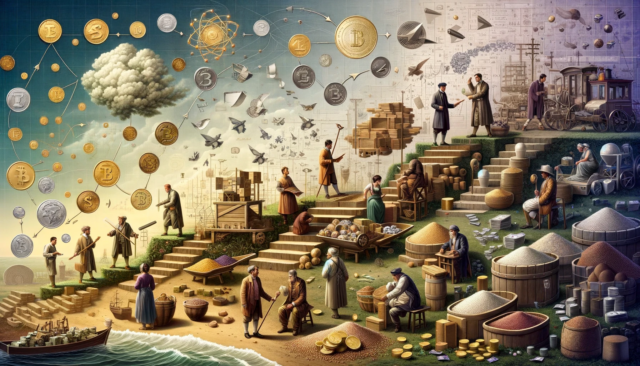The Mathematical Evolution of Currency: A Journey Through History and Innovation
From seashells to cryptocurrency, the ways we exchange value are as diverse as the civilizations that have employed them. Currency, in its many forms, has been a fundamental pillar of human progress. It is not just a means of trade, but a testament to social evolution, technological leaps, and the intricate dance between mathematics and economic thought. This article will illuminate the profound history of currency development, exploring its roots in barter and commodity money, and charting its path to modern systems, including the fascinating realm of cryptocurrencies. With a keen focus on the underlying mathematical principles, we’ll uncover how the quantification of value, exchange rates, and even economic theories have shaped the currencies we know today.
The Genesis of Exchange: Barter and Commodity Money
The origin of currency lies in the simple yet cumbersome barter system. In its earliest iteration, trade was direct – goods exchanged for other goods. A farmer might trade a bushel of wheat for a pair of shoes. But the barter system had inherent limitations. The need for a “double coincidence of wants” (e.g., both parties must desire what the other possesses) made transactions slow and inefficient. Additionally, determining the relative value of wildly disparate goods, say a cow versus a fishing net, posed a significant challenge.
To overcome these hurdles, societies began to rely on commodity money. Here, goods readily accepted by most people in the community gained currency-like status. Commonly used commodities included salt (hence the term ‘salary’), cattle, precious metals, and even decorative items like seashells. While they simplified exchange compared to barter, commodity currencies were often heavy, perishable, and difficult to divide into smaller values.
The Rise of Coinage: Quantifying Value
Around the 7th century BCE, a revolution swept across the world of currency – the advent of coinage. The kingdom of Lydia (modern-day Turkey) were likely the first to adopt the practice of minting standardized metal coins. Often stamped with official insignia, these coins offered several advantages. The use of precious metals, such as gold and silver, introduced an element of intrinsic value. Coins were portable, durable, and easily divisible, facilitating transactions both large and small.
The mathematical foundation of coinage is in the quantification of value. Each coin carried a specified weight and purity of metal, making it a tangible representation of an agreed-upon unit of value. Minting authorities assumed the power to both guarantee and manipulate that value, profoundly affecting trade and economies. The shift toward coinage represented a significant stride in the abstraction of money and enabled far more complex transactions than were possible with commodity currencies.
Paper Promises and Fractional Reserve Banking
The Chinese Tang Dynasty (618-907 CE) introduced a groundbreaking innovation: paper money. Initially created as receipts for deposited gold and silver, these notes gradually became the preferred medium of exchange due to their convenience. Yet, paper money also introduced complexities. Unlike commodity money, its value wasn’t directly tied to a physical substance. It relied on trust in the issuer – whether a merchant, a bank, or later, governments.
Paper currency further amplified the role of mathematics in the development of currency systems. The concept of fractional reserve banking emerged. Institutions realized that they could issue notes with a total value far greater than the precious metals held as reserves. This increased the money supply, providing much-needed liquidity for trade and economic growth. However, it also opened the door to the potential for inflation and economic instability if the delicate balance between reserves and issued currency was disrupted.
The Gold Standard and Mathematical Foundations
During the 19th century, many countries adopted the gold standard, fixing their currencies to a specific quantity of gold. This system aimed to provide stability and promote international trade. Currencies following the gold standard maintained fixed exchange rates against each other based on their relative gold values. Mathematical calculations were essential in determining these rates and regulating the international flow of gold and currencies.
The gold standard, while offering its perceived stability, had limitations. It restricted governments’ ability to adjust the money supply, sometimes leading to deflations or financial panics. As global trade and financial systems became increasingly complex, the rigidity of the gold standard proved unsustainable. Especially with the economic pressures of World Wars, many countries gradually abandoned it.
Fiat Currency, Central Banks, and Monetary Theory
The 20th century saw the dominance of fiat money — currency declared legal tender by a government, but not backed by a physical commodity. Modern nations possess a remarkable ability to create and manage what is essentially an abstraction. Central banks were established as the guardians of their respective currencies. Their actions play a pivotal role in steering economies and influencing the global financial system.
This period saw the rise of numerous monetary theories and schools of economic thought, driving innovation in currencies and financial markets. One of the most influential theories is the quantity theory of money. It proposes a direct relationship between the quantity of money in circulation and the general price level (and hence, inflation). Keynesian economics, emerging in the mid-20th century, advocated for government intervention to manage economic cycles, a philosophy that often called for the use of monetary policy tools to combat recessions.
Mathematics is the language through which these economic theories are expressed. Complex models and equations help central bankers and economists analyze the relationship between variables such as the money supply, inflation, interest rates, and economic growth. These are essential tools for making informed decisions that affect people’s financial wellbeing on individual and national levels.
The Digital Disruption: Cryptocurrencies
The dawn of the 21st century ushered in one of the most transformative events in the history of currencies: the rise of cryptocurrencies. Bitcoin, the first and most popular cryptocurrency, was born in 2009 as a response to the perceived shortcomings of traditional financial systems. Cryptocurrencies operate on decentralized digital ledgers called blockchains, offering a level of security, anonymity, and freedom from centralized control never seen before.
Mathematics forms the very heart of cryptocurrencies. Cryptography ensures their security, complex algorithms control their creation (known as ‘mining’), and sophisticated mathematical models govern their supply and demand. Unlike fiat currencies, the value of cryptocurrencies is primarily determined by market forces and investor sentiment, leading to sometimes extreme volatility. However, they represent a bold experiment, one that explores the possibility of currency systems that operate with less centralized control.
Future Horizons: The Possibilities of Programmable Money
As technology and mathematics continue to evolve, so will the concept of currency. The rise of programmable money, where code embedded in currencies dictates how and where it can be spent, raises intriguing possibilities. Central bank digital currencies (CBDCs), digital forms of fiat currencies, are being researched and developed by various nations worldwide. They could enhance financial efficiency and inclusion while also giving central banks greater power over monetary policy.
The history of currency is inextricably linked with the evolution of human society itself. It is a saga of innovation, adaptation, and the interplay between trust and technology. Mathematics has provided the tools to quantify value, manage complexities, and build intricate financial systems. As we move into the future, mathematics will undoubtedly continue to pave the way for new forms of currency, potentially transforming how we interact with value and revolutionizing the very concept of money.


